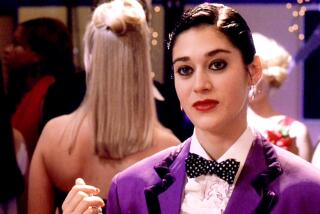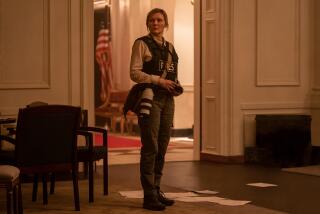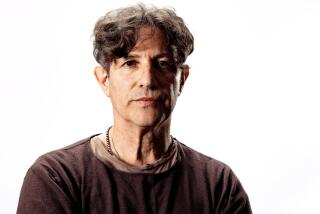Taking hyper-real to new extremes
Talk about the fast and the furious. The Wachowski brothers are making a live action version of “Speed Racer,” the ‘60s Japanese-animated series that gives a whole new meaning to the idea of “X-treme” motor sports. ¶ Like the cartoon, the action adventure is focused around an elite group of professional racers -- among them Speed, played by “Into the Wild’s” Emile Hirsch -- who vie for primacy on the international circuit. They hurtle around torquing loop the loops in spaceship-like roadsters and thunder across far-flung road race locales in tricked out rally cars, all at speeds surpassing 300 mph. Their gleaming machines explode into the air using “jump jacks” on the vehicles’ undercarriages and drivers battle tooth, nail and cylinder to knock out one another. Fending off hell-bent competitors, corrupt corporate sponsors and booby traps, they’re as likely to wind up in a fiery wreckage as to come in under the checkered flag -- even if in Speed’s PG-friendly world, nobody ever dies in a crash. ¶ Befitting a movie that owes a stylistic debt to the early ‘60s, as well as notions of what the future would look like, writer-directors Andy and Larry Wachowski came up with a mashed-up nickname for the film’s melange of Formula 1, the X Games and demolition derby.
“Car-Fu -- that’s what the boys were calling it,” said “Speed Racer” producer Joel Silver, speaking for the notoriously media-averse Wachowskis, the dystopian auteurs behind the blockbuster “Matrix” trilogy. “Cars fighting in the air.”
Chief among them, the hero’s new wheels: a vehicle that looks to be a kind of rocket-propelled F1 car on steroids called the Mach VI -- the next generation from the cartoon’s Mach V. “That wasn’t on the show,” visual effects supervisor John Gaeta confirmed, explaining that races will compose about a third of the film’s action.
With “Speed Racer’s” March post-production deadline quickly approaching -- the film is due out in May -- the filmmakers are scrambling to finalize their vision of a candy-hued, effects-heavy “bright, optimistic, exaggerated reality” -- one they say will eventually include some 2,000 visual effects (nearly triple the amount in most CGI-aided movies) and employ what they are calling “2 1/2-D” technology that the notoriously exacting Wachowskis helped innovate especially for the project.
“The car races in ‘Speed Racer’ couldn’t have been filmed until now -- there would have been no way to do these races without the effects we created,” Silver said. “There are no cars, no stands, no people. It’s a composite world and most of the movie was shot on green screen.”
Unlike most movies in which computer generated imagery stands in for sets, extras, props and even production design (“Sky Captain and the World of Tomorrow” please stand up), “Speed Racer” is using high definition digital video to blur genre boundaries.
“We looked at the textures and attitude of the original ‘Speed’ and wanted to be faithful to the core concepts of the story,” Gaeta said. “But we thought it would be fascinating to take the structure of old anime and modernize it. It’s computer generated but it’s not a cartoon. It’s a high-fidelity interpretation of anime.”
Anime has always presented a uniquely stylized hyper-reality in place of formal realism. So in keeping with the source material -- “Speed Racer” was among the earliest Japanimation to cross over to western audiences -- the filmmakers rendered backgrounds and POVs with deliberate imperfections and weird pixelation. “The perspectives were deliberately done wrong to have an emotional impact rather than a realistic one,” said visual effects supervisor Dan Glass. “We wanted an impressionistic feel. This is a movie for kids and families. They tend to not have as many judgments in place about what cinema should look like.”
To achieve what they call “Speed Racer’s” “hyper” color palette, production designers mined the work of anime pioneer Hayao Miyazaki (“Spirited Away”), Tokyo-born pop artist Takashi Murakami, the high-concept fashion photography of David LaChapelle and neo-noir shoot ‘em up “Sin City,” among myriad other avant pop influences.
Yet the vast majority of the movie’s baroquely detailed backdrops exist only on a virtual plain. Location scouts traveled far and wide, exhaustively photographing interiors and landscapes in places such as Italy, Morocco, Austria, Turkey and Death Valley. From there, effects technicians digitally reassembled 360-degree image capture tableaux of each location, often combining several to create one set piece, and then punching them up with a vibrant pastel color palette. As well, they inserted layer upon layer of impossible visual details, such as a troupe of synchronized swimmers who are visible through a window, just to the periphery of the action in one scene.
“This takes place at a castle in Potsdam, Germany, where they won’t allow you to shoot a film,” Glass said, running a sequence on a monitor in a Burbank post-production studio. “But we photographed it in such detail, here it is. We’re doing things that were once logistically impossible.”
Still, when the actors arrived on cavernous green screen sets erected at Germany’s Babelsberg Studios last summer, the effects supervisors -- working in close conjunction with the Wachowskis and cinematographer David Tattersall -- had some explaining to do. “Gaeta would always be on set,” Hirsch said. “He’d take out his laptop and for every scene, he’d show me what I was supposed to be looking at. So [in terms of] the backgrounds, I was there. I just wasn’t in it.”
Christina Ricci plays Speed’s girlfriend Trixie and, the actress admitted, she didn’t know -- and still really only has an abstract notion of -- what she was getting into with “Speed.”
But in the end, the Wachowskis’ obsession with detail persuaded her to suspend doubt. “It’s one of those things where all of us just said, ‘They have something detailed and complete in their heads. We don’t know what that is. So let’s just go with it,’ ” Ricci said. “It was crazy!”
--
More to Read
Only good movies
Get the Indie Focus newsletter, Mark Olsen's weekly guide to the world of cinema.
You may occasionally receive promotional content from the Los Angeles Times.







